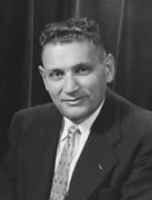Solomon Kullback (nonfiction): Difference between revisions
Jump to navigation
Jump to search
No edit summary |
No edit summary |
||
| Line 2: | Line 2: | ||
The Kullback–Leibler divergence is named after Kullback and [[Richard Leibler (nonfiction)|Richard Leibler]]. | The Kullback–Leibler divergence is named after Kullback and [[Richard Leibler (nonfiction)|Richard Leibler]]. | ||
== In the News == | |||
<gallery> | |||
</gallery> | |||
== Fiction cross-reference == | |||
* [[Crimes against mathematical constants]] | |||
* [[Gnomon algorithm]] | |||
* [[Gnomon Chronicles]] | |||
* [[Mathematician]] | |||
* [[Mathematics]] | |||
== Nonfiction cross-reference == | |||
* [[Cryptography (nonfiction)]] | |||
* [[Mathematician (nonfiction)]] | |||
* [[Mathematics (nonfiction)]] | |||
External links: | |||
* [https://en.wikipedia.org/wiki/Solomon_Kullback Solomon Kullback] @ Wikipedia | |||
Attribution: | |||
[[Category:Nonfiction (nonfiction)]] | |||
[[Category:Cryptanalysts (nonfiction)]] | |||
[[Category:Mathematicians (nonfiction)]] | |||
[[Category:People (nonfiction)]] | |||
[[Category:Photographs (nonfiction)]] | |||
[[Category:Portraits (nonfiction)]] | |||
Revision as of 18:08, 3 April 2019
Solomon Kullback (April 3, 1907 – August 5, 1994) was an American cryptanalyst and mathematician, who was one of the first three employees hired by William F. Friedman at the US Army's Signal Intelligence Service (SIS) in the 1930s, along with Frank Rowlett and Abraham Sinkov. He went on to a long and distinguished career at SIS and its eventual successor, the National Security Agency (NSA). Kullback was the Chief Scientist at the NSA until his retirement in 1962, whereupon he took a position at the George Washington University.
The Kullback–Leibler divergence is named after Kullback and Richard Leibler.
In the News
Fiction cross-reference
Nonfiction cross-reference
External links:
- Solomon Kullback @ Wikipedia
Attribution:
